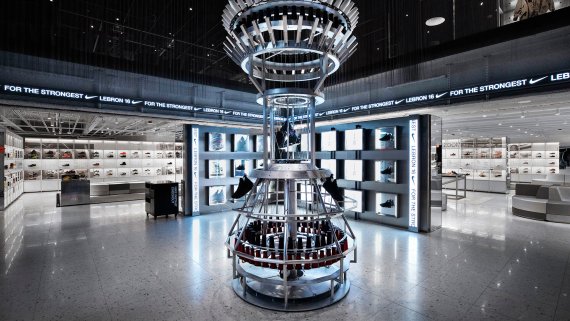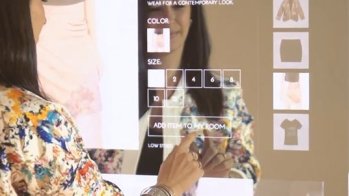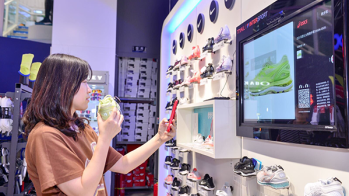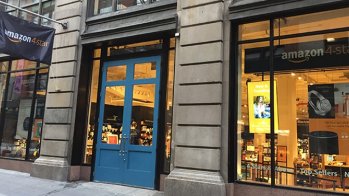
The current Christmas business has just proven it: Online shopping currently has several advantages: more choice, bargain prices, lots of product information, time savings, 24-hour shopping opportunity. All of these are heavyweight arguments making life difficult for stationary retail. What should be done? “Something urgently needs to be done here,” says Professor Holger Moths, of Prof. Moths Architekten. The architect developed the award-winning Globetrotter houses years ago, and set another milestone in 2018 with the L&T Sporthaus in Osnabrück.
Shopping needs to become an experience, and thus complement the online offerings in an unbeatable way. On this the experts agree. Specialty sports retail has the best prerequisites for this. Maik Drewitz of the shopfitting specialist Umdasch The Store Makers: “Sports retail in particular can make use of its young, dynamic image, especially by creating experience spaces. Hardly any other product is as suited to testing on site as sporting goods.” These examples show how this can be done.
The L&T sports house in Osnabrück is undisputedly one of the absolute showcase projects of specialty sports retail in 2018. What was realized there is second to none. From the world’s first department store with a standing wave to its own fitness club with integrated altitude training, L&T presents itself as a true experience center for sports. “Here, shopping and trying out the product range are combined for a shopping experience, and younger customers from the online generation are also attracted back to a retail store,” explains Holger Moths.
The Best Digital Concepts for Stationary Stores in Pictures
After a good two years of reconstruction, the Schuster sports house in Munich was reopened in October. On seven floors and more than 5,000 square meters - about 1,000 more than before - there is now an even more extensive range of sporting goods geared to new target groups. New is an urban outdoor department, a sports floor for women, a bar, and a bouldering area. Blocher Partners realized the project. Jutta Blocher’s conclusion: “Schuster competently weaves many small events into its story. Examples are the sports level for women on the first floor or the multifunctional area on the top floor, which offers space for yoga courses, but also for other events, and dining.”
The stationary store world may no longer be separated from the online world. Both belong together and create space for new ideas. Wolfgang Gruschwitz and his company have specialized in digital in-store solutions and offer a “Digital Transformation Lab” in their Munich showroom, where you can experience and try out the technology up close. Gruschwitz: “Digital support is going to become more and more important: A connection between analog, haptic experiences - cleverly combined with data collecting, informing, making available and logistically supporting digitalization.”
The new Intersport concept takes a step forward in many areas: more customer appeal, more emotionality, more digital elements. Digital technology can shorten processes, provide additional information, and ultimately help to better understand the customer. Tina Jokisch of Schwitzke & Partner, which developed Intersport’s new concept: “In addition, it can bolster the consultant in the shop so that they can take care of the customer without restrictions. Because their needs will be the 100 percent focus of attention in the future.”
“The store will mutate into a workshop and a field of experimentation, the products will become more tangible and individual," is the forecast by Wolfgang Gruschwitz. One current example of this is Nike. Nike had two spectacular new openings to offer this fall: the opening of the new Nike flagship stores in New York, the so-called House of Innovation 000 on Fifth Avenue, and the equally ambitious House of Innovation 001 in Shanghai. There on the sixth floor is the Nike Expert Studio, where customers can customize their products. The area looks as if the customer has landed directly on the Nike design floor, with several material samples and computers.
A distinction has to be made between shopping and buying. The aim of the new store concepts is not so much sales – which can still take place online later – as the creation of a close connection to the customer. Hospitality is therefore an important keyword for store designers. Dining concepts are often integrated into stores for this purpose. In the new Burton flagship store in Innsbruck, for example, a bar has been installed that invites visitors to linger in complete silence. Gruschwitz: “It is important that the customer comes back, that they connect with the place and perceive it as a place for solutions and advice: in short, as a ‘place to be’ for sports or fashion.” Tommy Hilfiger, for example, is also combining digital elements with the theme of hospitality in its London flagship store. “In the People’s Place, the store café, visitors have access to the label’s online store via interactive screen tables, the opportunity to order Click & Collect, and their own City Magazine with the hottest London tips,” says Tina Jokisch of Schwitzke & Partner, which realized the store.
What role does the sales staff play in these ingenious design temples? With the focus on the experiential character of business, people are moving more into the foreground than ever before. Tina Jokisch: “Many retailers underestimate the human factor in the form of competent, service-oriented employees! Without a good staff to inspire the visitor and leave a good feeling behind, the most beautiful store is only half as good.”

 Sports BusinessSki Mountaineering Goes Olympic: What Milano-Cortina 2026 Means
Sports BusinessSki Mountaineering Goes Olympic: What Milano-Cortina 2026 Means
- ISPO awards
- Mountain sports
- Bike
- Design
- Retail
- Fitness
- Health
- ISPO Job Market
- ISPO Munich
- ISPO Shanghai
- Running
- Brands
- Sustainability
- Olympia
- OutDoor
- Promotion
- Sports Business
- ISPO Textrends
- Triathlon
- Water sports
- Winter sports
- eSports
- SportsTech
- OutDoor by ISPO
- Heroes
- Transformation
- Sport Fashion
- Urban Culture
- Challenges of a CEO
- Trade fairs
- Sports
- Find the Balance
- Product reviews
- Newsletter Exclusive Area
- Magazine


















